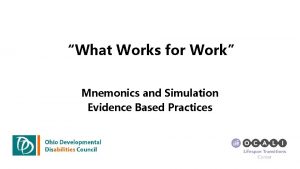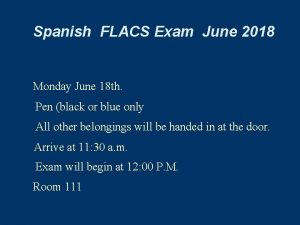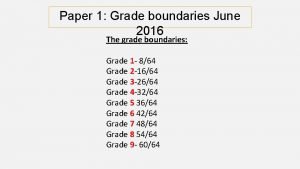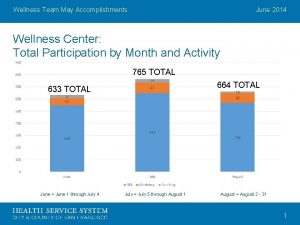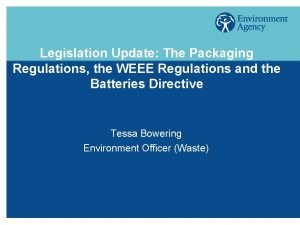Wellness Plan Regulations June 2015 1 Wellness Plan

















- Slides: 17

Wellness Plan Regulations June 2015 1

Wellness Plan Final Regulations Background • HIPAA non-discrimination rules prohibit discrimination in health plans based on health status – Wellness programs that base eligibility, cost of coverage, or benefits (i. e. amount of co-pay, deductible, etc. ) on health factors are “discriminatory” – HIPAA wellness regulations set gridlines for programs to be considered nondiscriminatory • Important note: HIPAA wellness rules do not apply to wellness incentives that simply provide cash, gifts, etc. which do not impact the health plan

Wellness Plan Final Regulations • Effective date of final rules – Plan years starting on or after 1/1/2014 • Definitions – Participatory wellness program • Reward not based on a specific health outcome – “Health contingent” wellness program • Require an individual to satisfy a standard related to a health factor to obtain a reward • Require an individual with an identified health factor to take action to obtain a reward – Provide a reward to employees identified through a health assessment as having high cholesterol to take additional steps such as meeting with a health coach to qualify for a reward

Wellness Plan Final Regulations • Types of Wellness Programs – Participatory Wellness Programs • Do not provide a reward or do not include any conditions for obtaining a reward that are based on an individual satisfying a standard that is related to a health factor • As in the past rules do not impose a limit on incentives or rewards for participatory programs • Examples described in the guidance include: – a program that reimburses employees for all or part of the cost of membership in a fitness center – a diagnostic testing program that provides a reward for participation and does not base any part of the reward on outcomes – a program that provides a reward to employees for attending a monthly, no-cost health education seminar

Wellness Plan Final Regulations • Types of Wellness Programs – Participatory Wellness Programs • Design warning: Basing eligibility for a plan on a participatory program will effect health reform requirements for applicable large employers – Example: Employees cannot participate in the employers only health plan unless they complete a health risk assessment would mean some employees are not eligible for coverage triggering possible employer penalties under the ACA – Solution would be to condition eligibility for a buy up plan on participation, but allow all employees the choice to enroll in the lower option plan

Wellness Plan Final Regulations • Health-Contingent Wellness Programs – Require an individual to satisfy a standard related to a health factor to obtain a reward • Health-contingent wellness programs are divided into activity-only & outcome-based wellness programs – Activity-only health contingent wellness program • Individual is required to perform or complete an activity related to a health factor in order to obtain a reward, but is not required to attain or maintain a specific health outcome – Examples include walking, diet, or exercise programs. • Individuals participating in an activity-only wellness program may be unable to participate in the activity due to a health factor, so these individuals must be given a reasonable alternative opportunity to qualify for the reward (more later)

Wellness Plan Final Regulations • Outcome-based health contingent wellness program – Individual must attain or maintain a specific health outcome (such as not smoking or attaining certain results on biometric screenings) in order to obtain a reward – As with the activity based programs, individuals who do not attain or maintain the specific health outcome must be offered an alternative to earn the reward • An activity based option may be offered as an alternative to the outcome based program to achieve the same reward.

Wellness Plan Final Regulations • 5 Criteria for Health-Contingent Wellness Programs – Frequency of Opportunity to Qualify - Must be given the opportunity to qualify for the reward at least once per year – Size of Reward - Maximum reward cannot exceed 30% of the total cost of employee-only coverage - 50% for programs designed to prevent or reduce tobacco use • The combined incentive for a program that includes both outcomes based rewards, and a reward related to tobacco, may not exceed 50% of the cost of coverage. – Reasonable Design • Reasonable chance of improving the health of, or preventing disease …is not overly burdensome, is not a subterfuge for discrimination… • Must provide a reasonable alternative standard to qualify for the reward for all individuals who do not meet the initial standard that is related to a health factor (more later)

Wellness Plan Final Regulations • 5 Criteria Continued – Uniform Availability and Reasonable Alternative Standards • The full reward must be available to all similarly situated individuals and individuals who qualify by satisfying a reasonable alternative – Notice of Availability of Reasonable Alternative Standard • Must disclose the availability of a reasonable alternative standard in all plan materials describing the terms of a health-contingent wellness program and in any disclosure that an individual did not satisfy an initial outcome-based standard. • Model notice language was provided in the guidance: • If plan materials merely mention that a wellness program is available, without describing the wellness program terms, this disclosure is not required in that material

Wellness Plan Final Regulations • Reasonable Alternatives – Plans are not required to establish a reasonable alternative standard in advance of a request • Can provide the same reasonable alternative standard for a class of individuals, or on an individual basis – Examples of reasonable alternative criteria in regulations: • If the reasonable alternative standard is completion of an educational program, the educational program must be made available at no cost to the individual • The time commitment required must be reasonable • If the reasonable alternative standard is a diet program, the participation fee must be paid by the plan (but not the cost of food) • If a physician states a standard is not medically appropriate, a reasonable alternative standard must accommodate the recommendations of the physician

Wellness Plan Final Regulations • Reasonable Alternative (continued) – Requirements apply differently to activity-only or outcome-based wellness program – Activity-only wellness programs • Must allow a reasonable alternative for any individual for whom it is either unreasonably difficult due to a medical condition, or for whom it is medically inadvisable to attempt to satisfy the standard • The employer is permitted to seek verification, such as a statement from the individual’s personal physician

Wellness Plan Final Regulations • Reasonable Alternative (continued) – Outcome-based wellness programs • Must allow a reasonable alternative standard for obtaining the reward for any individual who does not meet the initial standard – If the alternative standard is to meet a different (easier) level of the same standard, reasonable time must be given – An individual must be given the opportunity to comply with the recommendations of the individual’s personal physician as a second reasonable alternative standard • Employers are not allowed to require verification, such as a statement from the individual’s physician, that a health factor makes it unreasonably difficult to satisfy the outcomes based standard – If an employer provides an activity-only wellness program as an alternative to the outcome-based wellness program, then verification may be requested with respect to the activity-only component of the program.

EEOC proposed Wellness regulations Background • The Americans with Disabilities Act (ADA) prohibits employment discrimination based on disability • ADA restricts when an employer may make disability-related inquiries or require medical examinations – Wellness programs often include elements of both • A health risk assessment (HRA) may include disability-related questions • Biometric screening programs are considered medical examinations • Importantly, the ADA includes exceptions for certain types of health plan and wellness programs – An employer may make disability-related inquiries or conduct medical examinations if the program is “voluntary”

EEOC proposed Wellness regulations Proposed Regulations • Changes to Incentive Limits – If the wellness program includes disability-related inquiries and/or medical examinations, employers can offer incentives of up to 30% of the total cost of employee-only coverage and the program – This limitation applies to all wellness programs - participatory, healthcontingent, or a combination of the two • This is an area in which the EEOC rules differ significantly from existing HIPAA wellness rules • The current HIPAA restrictions on incentives do not apply to participatory programs. Prior to this EEOC rule, employers could have designed participatory programs with incentives exceeding 30% of the premium. Now if that incentive involves a program that includes disability-related inquiries and/or medical examinations, the maximum incentive possible will be 30%, even if it is a participatory program.

EEOC proposed Wellness regulations Proposed Regulations • Special rules for smoking cessation programs – A smoking cessation program that only asks employees whether they use tobacco would not be considered a disability-related inquiry or medical examination, and would not be subject to the EEOC rules. – A wellness program requiring employees to submit to medical testing to determine tobacco use is a medical examination limiting even tobacco-related incentives to 30%.

EEOC proposed Wellness regulations Proposed Regulations • Other Changes – Wellness incentives can be offered to employees as long as participation is not required and nonparticipating employees are neither denied coverage under any employer group health plan nor subject to any adverse employment action. – This condition directly addresses a strategy that some employers have begun to adopt in which participation in the employer’s health plan is contingent on the employee’s completing an HRA. Under these new rules, this strategy would violate the ADA. • Notice Requirement – Employers must also provide employees with a notice that includes a description of the medical information collected, who will have access to it, and how it will be used and kept confidential

EEOC proposed Wellness regulations Health Reform and Affordability and Minimum Value • “Affordability” for purposes of employer penalties under the 4980(H) shared responsibility rules will be based on the cost for an employee to participate at non-wellness rates – Exception for smoking related wellness rates – in this case affordability is based on non-smoker rate – Design challenges when rate is based on both wellness and smoking criteria • Minimum Value based on non-wellness design – Example: Plan with $7000 deductible that does not meet MV, but employees who complete wellness program are given a $1500 HRA • Employer would not be considered offering MV plan
 Flacs checkpoint b french exam
Flacs checkpoint b french exam Checklist audit iso 37001
Checklist audit iso 37001 Iso 9001:2015 communication plan example
Iso 9001:2015 communication plan example Wellness recovery action plan examples
Wellness recovery action plan examples Wellness recovery action plan examples
Wellness recovery action plan examples Daily maintenance plan wrap
Daily maintenance plan wrap Th30720
Th30720 Developing a personal wellness plan
Developing a personal wellness plan Wellness recovery action plan activities
Wellness recovery action plan activities 30 days has september april june and november
30 days has september april june and november Flacs exam
Flacs exam June 2007 physics regents
June 2007 physics regents June 2005 calendar
June 2005 calendar To a daughter leaving home and poem for my sister
To a daughter leaving home and poem for my sister Good morning 1 june
Good morning 1 june Lottery in june corn be heavy soon page number
Lottery in june corn be heavy soon page number Danswer
Danswer Welcome june blessings
Welcome june blessings









